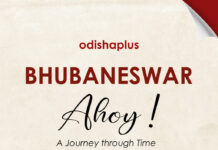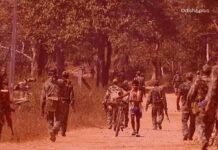OdishaPlus Bureau
The grip that the Ramayana and the Mahabharata have over the minds, memories, imaginations, and identities of Indians has no parallel in the literary history in India, or in any other literary tradition. And, in this, the Mahabharata has an undisputed pre-eminence over the Ramayana. Speaking about the Mahabharata, Swami Vivekananda said in 1900:
In speaking of the Mahabharata to you, it is simply impossible for me to present the unending array of the grand and majestic characters of the mighty heroes depicted by the genius and master-mind of Vyasa. The internal conflicts between righteousness and filial affection in the mind of the god-fearing, yet feeble, old, blind King Dhritarashtra; the majestic character of the grandsire Bhishma; the noble and virtuous character of the royal Yudhishthira, and of the other four brothers, as mighty in valour as in devotion and loyalty; the peerless character of Krishna, unsurpassed in human wisdom; and not less brilliant, the characters of the women – the stately queen Gandhari, the loving mother Kunti, the ever-devoted and all-suffering Draupadi – these and hundreds of other characters of this Epic and those of the Ramayana have been the cherished heritage of the whole Hindu world for the last several thousands of years and form the basis of their thoughts and of their moral and ethical ideas.
This is an extraordinary phenomenon and it calls for interpretation and a dispassionate understanding. It took the scholars at the Bhandarkar Institute in Pune several decades to place this narrative in a sensible textual form by collecting the vast repository of manuscripts from different parts of India, spread over places of traditional learning as apart from each other as Manipur and Madras, Varanasi and Tanjore, Sankheda and Kolkata.
They faced the complicated task of comparing verse by verse and phrase by phrase the 1,259 handwritten manuscripts, scribed in different centuries and diverse in writing styles and script conventions. Beginning in April 1919, they could complete the project only forty-seven years later, in September 1966, and they produced a printed version of the epic containing 89,000 verses, with notes and editorial comments, with the material excluded from the main text placed in footnotes.

Just as the Kurukshetra war had a series of warriors as generals – Bhishma, Drona, Karna, and Ashwathama – the project had a series of extraordinary editors such as VS Sukthankar, SK Belvalkar, SK De, and RN Dandekar. After a lived history of two millennia as a text continuously circulating in the social imagination, the “original” Sanskrit text of the epic finally came to be consolidated, standardised, authenticated, and brought into print five decades ago.
Till then, it remained in existence as an “oral” epic despite having been first composed by a poet, “gathered into a larger version” by another poet, “written” by Ganesha as the myth goes, and reproduced in written manuscripts by generations of scholiasts, as well as translated into several Indian languages and languages from elsewhere in the world, including Persian and English.
Completely unrelated to this project, but during more or less the same period, Sri Aurobindo produced a series of long poems in English based on the Mahabharata. His Love and Death depicts the Ruru–Priyamvada episode, Urvasie is about the story of the Pururavas and Urvashi, and the 24,000-verse-long epic Savitri dwells upon the Savitri–Satyavan relationship. His engagement with the epic began in the 1890s and continued till the 1940s.
The number of translations of various parts of the Mahabharata and their musical or dramatic representations in Indian languages during medieval times, and more so since printing technology transformed literary productions during the last two hundred years, has been phenomenally large.

The team included Al-Badayuni, who did the first round of the translation, Faizi, Naqib Khan, Mulla Sheri, and a few others who did further work on a few parvas each. Akbar commissioned artists to illustrate the manuscript and titled the translation Razmnama, the history of a war. The illustrations depicted events from the Mahabharata as well as the Ramayana.
It appears that some of the artists retrenched by Akbar went out to the Agra bazaar and sold their unused paintings. Some of these may be seen in a publication put together by Ashok Kumar Das in 1985, called Paintings of the Razmnama: The Book of War.
Translations of the Mahabharata into Tamil were carried out as early as the ninth century by the poet Perundevanar, under the title Bharat Venba, and, later in the fourteenth century, by Villiputhurar. The Telugu Mahabharata, the first great literary work synchronous with the birth of the Telugu language, was composed by Nannaya in the eleventh century.

The phenomenal Narayanappa, who came to be recognised as Kumar Vyasa, a poet of great literary prowess, produced the Kannada version of the Mahabharata. Several episodes from the Mahabharata were translated frequently into other languages, for instance, Gujarati and Bangla. So far, there have been no attempts to collect all such translations in full length or abridged versions for a comprehensive comparison. As and when that is accomplished, it will become possible to know more about the original Mahabharata as it exactly was, and to understand more fully the history of its cultural impact.
One such work is the long poem Bharath in the Garasiya variety of Bhili spoken in the Banaskantha-Sabarkantha area on the border of Rajasthan and Gujarat. A dedicated schoolteacher with a doctorate in folk literature, Bhagwandas Patel from Banaskantha spent several decades documenting the text and the performance practices of the Bhils’ Bharath. His text is now available in Gujarati, Hindi, and English versions.
The plot of the Mahabharata of the Garasiya Bhils and the plot in the “critical edition” Mahabharata have shared elements, but the differences are quite striking. For instance, the vastraharan, disrobing of Draupadi, does not occur in the tribal epic. As against the sarpayagnya in the “critical edition”, the tribal text depicts Vasuki, the king of serpents, as being far more heroic and triumphant than any of the Kuru heroes. In the Bhili version, Vasuki has a romping affair with Draupadi, and Arjuna is depicted as a mute spectator tied to the bedpost while Vasuki and Draupadi are in bed.

There is no Bhagavad Gita in the tribal epic, though Krishna as a character, and an important one, is present. Neither the Satyavan-Savitri story, nor the Nala-Damayanti story, and not even the Ruru- Pramadvara story are to be found in the Bhili Mahabharata. The rituals associated with its recitation and performance clearly indicate that the Bhili Mahabharata belongs to the realm of the sacred in their culture.
My idea of what an oral epic is, or can be, is shaped by the Bhili Mahabharata. I have read the documented text carefully and seen it performed several times. I have also spoken to the members of the community, who undertake years of training to perform the epic. It is clear to me that theirs is not a “vulgarisation” or a folk adaptation of the Mahabharata.
There are other such versions of the Mahabharata in existence in India. Besides, there are the Bhagavad and the Gita and, together, they continue to keep the Mahabharata tradition alive in India. Indians, old or young, in cities or in villages, think that they know the Mahabharata although they rarely read the poem in print. There is a widely shared superstition that it is inauspicious to keep copies of the entire text at home.
No such taboo is attached to the Bhagavad Gita, and its copies are acquired and kept in homes. Most Indians in urban and semi-urban areas watch the Mahabharata on the TV screen, and many listen to oral renderings of some of the main episodes. Till the early twentieth century, the tradition of reciting verses from the Mahabharata during winter months continued in most parts of rural India. During the last few decades, the votaries of oral epic traditions have become rare
At present, one’s access to the epic has become somewhat reduced. Children are introduced to it through illustrated storybooks, and adults get to “see” it enacted on the TV screen. And yet, we like to believe that we know the Mahabharata. No other imaginative composition, no other literary work except perhaps the Ramayana, has held so much sway over such vast numbers and over such a long time span. No other epic anywhere in the world has so substantially been an integral part of a people’s emotional life as this epic.
(Excerpted with permission from Mahabharata: The Epic and the Nation, by GN Devy, Aleph Book Company,New Delhi.)





























